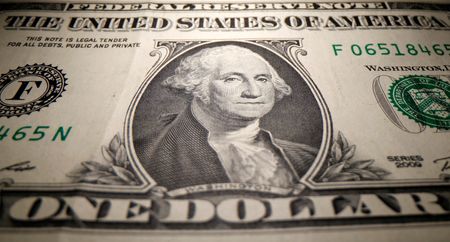By Saqib Iqbal Ahmed
NEW YORK (Reuters) -The U.S. dollar declined for a second consecutive day on Thursday as data showed weakness in the U.S. labor market, increasing expectations of another rate cut this year.
Meanwhile, sterling rose after the Bank of England kept rates unchanged ahead of this month’s budget. The central bank had been expected to leave rates unchanged, although markets had attached a one-in-three chance of a cut earlier on.
U.S.-based employers cut more than 150,000 jobs in October, marking the biggest reduction for the month in more than 20 years, a report by Challenger, Gray & Christmas said on Thursday as industries adopt AI-driven changes and intensify cost cuts.
Economic data from private sources has drawn increased investor interest amid the absence of official data during the U.S. government’s longest-ever shutdown.
Thursday’s weakness for the dollar follows a strong rally that started last week after the Federal Reserve tempered expectations for additional cuts this year amid limited economic data, persistent inflation, and internal disagreement among policymakers.
“The move lower in the dollar this morning was largely anticipated,” Antonio Ruggiero, FX & macro strategist at Convera, said.
“The lack of data from the government shutdown led investors to inflate optimism around the U.S.,” he said.
“When figures like the Challenger layoff report emerge, they easily trigger fear among investors who remain unconvinced about the durability of improved USD sentiment. That’s enough to prompt position unwinds, driving the dollar lower,” Ruggiero said.
Traders now see a 69% probability of a December rate cut, up from 62% the previous day, according to CME FedWatch. However, this remains well below the roughly 98% odds priced in late October.
The euro rose 0.3% against the dollar to $1.15225, while the dollar slipped 0.2% to 99.935 against a basket of major rivals, including the common currency.
The dollar fell 0.4% against the yen to 153.51 yen, pulling back from the near nine-month high of 154.48 yen touched on Tuesday.
BOE HOLDS PAT
Sterling traded 0.3% higher at $1.3088. It had touched a seven-month low of $1.3011 on Wednesday. [GBP/]
Before the BoE meeting, markets were pricing a one-in-three chance of a cut, while most analysts believed the central bank would likely hold fire.
By next month, the BoE will have seen official inflation and jobs data for October and November, and will know the extent of tax increases that are widely expected in finance minister Rachel Reeves’ November 26 budget.
Reeves paved the way on Tuesday for broad tax rises to avoid a return to “austerity”, framing her second annual budget as one of “hard choices” to protect public spending while reducing Britain’s debt.
“Holding rates today was the right decision, with inflation still nearly double the 2% target. The Bank will be in a stronger position after the dust settles from the budget, armed with additional jobs and inflation data, to judge whether further easing is warranted in December,” George Brown, Senior Economist at Schroders, said.
NOK RECOVERS AFTER NORGES BANK DECISION
The Norwegian crown currency was 0.2% higher against the euro at 11.76 after Norges Bank’s rate decision on Thursday. Against the dollar, it rose 0.1%.
Norway’s central bank kept its policy interest rate on hold at 4.0% to combat inflationary pressure, as unanimously predicted by analysts in a Reuters poll, and reiterated that further easing was likely in the year ahead.
Norges Bank began the current easing cycle in June and cut the policy rate again in September.
(Reporting by Joice Alves in London, additional reporting by Tom Westbrook in Singapore; Editing by Gareth Jones, Timothy Heritage and Andrew Heavens)











